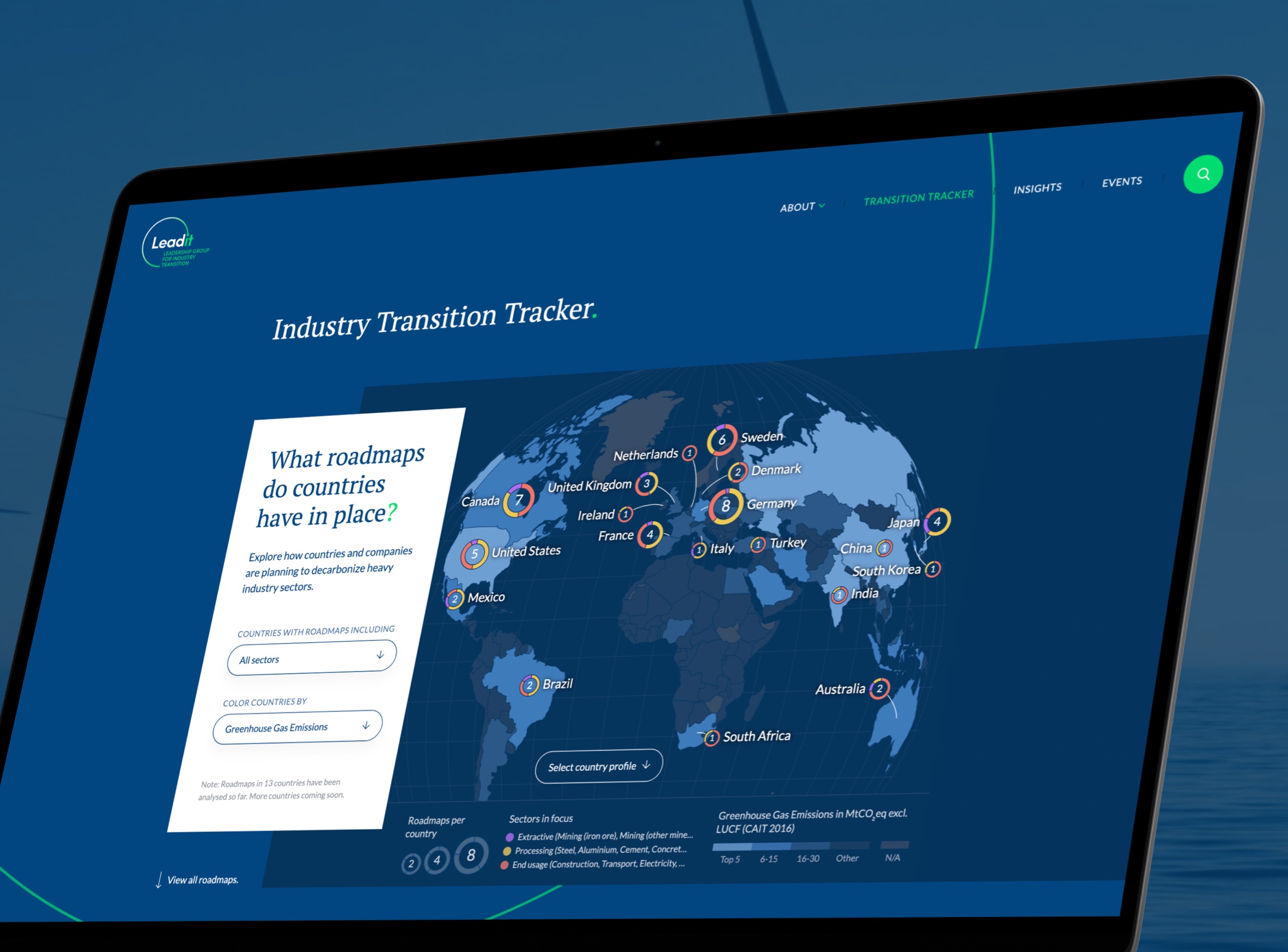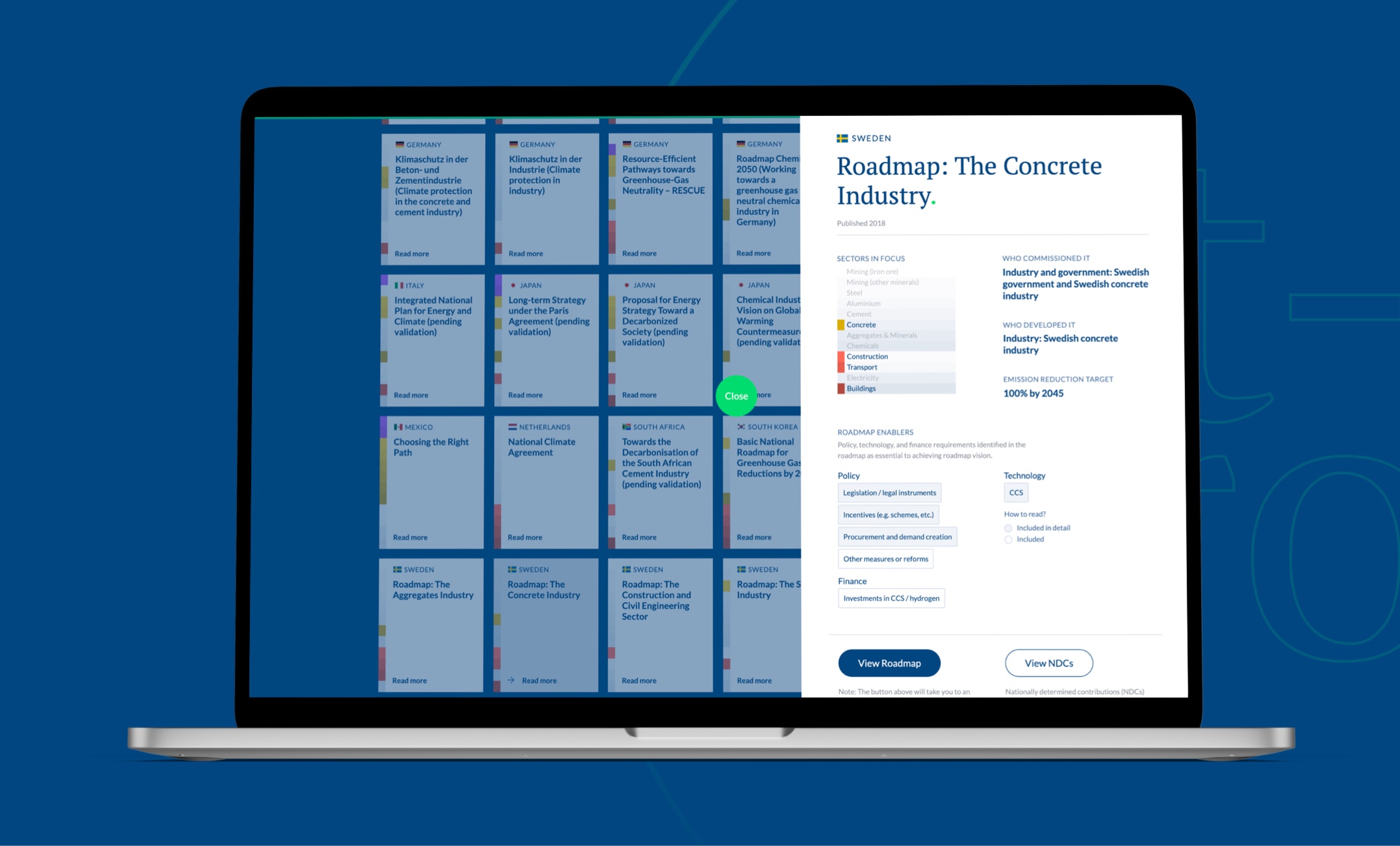Industry Transition Tracker.
Methodology.
Introduction
The Industry Transition Tracker is an online database that showcases publicly available industry transition roadmaps at national scale. The Tracker captures the extent to which countries have national and sectoral industry transition roadmaps in place. The Tracker’s functionalities allow users to explore various aspects of industry transition roadmaps, including different parts of industrial value chains they are targeting, decarbonization goals they aim to achieve, and technologies, policies and financial investments required for the roadmaps to be implemented.
The Transition Tracker has been launched with industry transition roadmaps developed by the thirteen member countries in the Leadership Group for Industry Transition. We continue to expand the Tracker to cover more countries and roadmaps. In 2021, the Transition Tracker will cover industry transition roadmaps in all G20 countries.

The objective
The aim of the Industry Transition Tracker is to create a comprehensive overview of global progress in industry transition toward national decarbonization targets, specifically net-zero carbon emissions by 2050. The Tracker is developed as a tool to visualise and trace the state of industry transition in different countries and heavy industry sectors. Its primary audience is government officials and industry professionals. The Tracker supports country and company efforts to design their own decarbonization roadmaps tailored to their specific targets, needs and capacities by showcasing the variety of existing industry transition roadmaps around the world.
Definitions and inclusion criteria
We define roadmaps as long-range strategic plans setting out actionable measures, steps, and milestones toward achieving a defined goal or vision. Roadmaps provide an essential understanding of proximity, direction, and some degree of certainty in planning. They start with a predetermined goal or target associated with a desirable future and set out possible pathways, strategic plans, actions, and policies required to reach that point. Roadmaps often describe a sequence of measures designed to bring about a desirable future.
Accordingly, industry transition roadmaps are defined as long-range strategic plans setting out actionable measures on technological innovation, policy, public-private partnership, and finance required to transform industries. In considering different wordings and terminologies, strategic plans with similar objectives and characteristics and comparable components have been given alternative names/titles. For example, the terms ‘roadmap’ and ‘pathway’ have been used interchangeably in many cases (Talebian & Johnson, 2020). Therefore, when selecting industry transition roadmaps to be showcased on the Tracker, we include all strategic plans towards decarbonization of industry sectors as relevant data points regardless of their titles.
The Tracker displays transition roadmaps that make reference to heavy industries within the ‘harder-to-abate’ industry sectors (e.g., cement, steel, and chemicals). In some cases, roadmaps are specifically focused on a particular heavy industry. In other cases – such as generic national scale roadmaps – roadmaps include measures and targets for a mix of industry sectors, including ‘harder-to-abate’ and ‘easier-to-abate’ industry sectors (e.g., electricity). We plan to expand the Tracker to include industry transition roadmaps developed for heavy-duty transport (e.g., heavy trucking, shipping, and aviation).
Sources of information
The Industry Transition Tracker uses only publicly available sources of information, with a strong emphasis on the original roadmaps and strategic plans, and official statements and documents by governments. Due to the lack of capacity to collect and analyse information in different languages, we only gathered and processes roadmaps that were either developed in English or had a brief or complete version translated to English. Links to original roadmap documents and any other sources of information (e.g., external databases) are included in the Tracker.
Search protocol
When searching for industry transition roadmaps and similar strategic plans for decarbonizing industry sectors, we specified a list of relevant terms, and defined a set of search keywords associated with each term (Table 1). The set of search keywords were used in all search processes to identify country-level information on industry transition roadmaps.
Table 1. Search terms and keywords
| Term | Definition | Search keywords | |
|---|---|---|---|
| 1 | Industry transition | Industry transition refers to low carbon solutions for industries, and decarbonization pathways for industry sectors to implement carbon emission mitigation measures. |
|
| 2 | Roadmap | Roadmaps are long-range strategic plans setting out actionable measures on innovation, policy, public-private partnership, and finance required to transform industries. |
|
| 3 | Harder-to-abate industries | Harder-to-abate sectors are economic sectors with relatively higher abatement costs than the rest of the economy. These include heavy industries (cement, steel, chemicals) and heavy-duty transport (heavy-duty road transport, shipping, aviation). |
|
| 4 | Visions | Visions are elaborations of a desirable future, emphasising a pre-determined goal or target in the future. Visions are often the end goal of decarbonization pathways and roadmaps (e.g., a set emission target, net-zero by 2050, etc.). Visions are also sometimes referred to as normative scenarios. |
|
| 5 | Policy for industry transition | Any national scale laws, legislation, regulations, etc. supporting industry transition could also be laying out the vision and steps and measures to take towards industry transitions. In this sense, these policy documents could be equivalent to our definition of roadmaps. |
|

Analysis
We performed content analysis on the original roadmaps and strategic plans and developed a coding protocol to extract the following information:
A. Descriptive information:
- Decarbonization visions and emission target
- Actors commissioning and developing the roadmaps
- Industries and sectors targeted in the roadmap
B. Requirements essential for achieving decarbonization:
- Policy levers and enablers
- Technology demands and innovations
- Financing needs and options
To provide a better understanding of the roadmaps’ targeted industries, we clustered industry sectors into three categories including extractive, processing, and end-use based on a value chain perspective. According to this clustering protocol, roadmaps specific to a certain industry (e.g., cement) fell only under one category, while generic roadmaps setting measures for several industries within the value chain (e.g., built environment) were coded under more than one industry sectors.
We categorized the actors involved in the development of roadmaps into three general groups including government, industry, and civil society. All ministries and government branches are labeled as ‘government’, companies and private business sectors are tagged as ‘industry’, and non-governmental organizations, universities and research institutes fall under the tag ‘civil society’.
Moreover, we created country profiles for each country under analysis to provide additional information on each country’s i) level of development, ii) total income from industry sectors, iii) total GHG emission, iii) total GHG emission from industry sectors, iv) count of all industry roadmaps by industry and sectors, and v) commitment to industry transition in National Determined Contributions (NDC).
We reviewed all NDCs developed by the countries under analysis to see what mitigation measures were planned to support low-carbon industrial transitions. To understand the extent of focus on industry transition measures in the NDCs, we created a rating system, which we dubbed the “NDC Industry Scorecard”, based on the degree of specificity and broad sectoral coverage of the proposed measures. The results of this parallel analysis process are shown as ‘NDC scores’ on the Tracker’s country profiles.
Data validation
Where possible, all country-level information collected and presented in the Tracker has been reviewed by country members representatives in the Leadership Group for Industry Transition.
